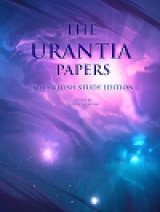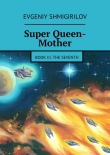
Текст книги "The British Study Edition of the Urantia Papers"
Автор книги: Tigran Aivazian
Жанр:
Религия
сообщить о нарушении
Текущая страница: 25 (всего у книги 295 страниц)
15:5.1 The bulk of the mass contained in the suns and planets of a superuniverse originates in the nebular wheels; very little of superuniverse mass is organized by the direct action of the power directors (as in the construction of architectural spheres), although a constantly varying quantity of matter originates in open space.
15:5.2 As to origin, the majority of the suns, planets, and other spheres can be classified in one of the following ten groups:
15:5.3 1. Concentric Contraction Rings. Not all nebulae are spiral. Many an immense nebula, instead of splitting into a double star system or evolving as a spiral, undergoes condensation by multiple-ring formation. For long periods such a nebula appears as an enormous central sun surrounded by numerous gigantic clouds of encircling, ring-appearing formations of matter.
15:5.4 2. The Whirled Stars embrace those suns which are thrown off the great mother wheels of highly heated gases. They are not thrown off as rings but in right– and left-handed processions. Whirled stars are also of origin in other-than-spiral nebulae.
15:5.5 3. Gravity-explosion Planets. When a sun is born of a spiral or of a barred nebula, not infrequently it is thrown out a considerable distance. Such a sun is highly gaseous, and subsequently, after it has somewhat cooled and condensed, it may chance to swing near some enormous mass of matter, a gigantic sun or a dark island of space. Such an approach may not be near enough to result in collision but still near enough to allow the gravity pull of the greater body to start tidal convulsions in the lesser, thus initiating a series of tidal upheavals which occur simultaneously on opposite sides of the convulsed sun. At their height these explosive eruptions produce a series of varying-sized aggregations of matter which may be projected beyond the gravity-reclamation zone of the erupting sun, thus becoming stabilized in orbits of their own around one of the two bodies concerned in this episode. Later on the larger collections of matter unite and gradually draw the smaller bodies to themselves. In this way many of the solid planets of the lesser systems are brought into existence. Your own solar system had just such an origin.
15:5.6 4. Centrifugal Planetary Daughters. Enormous suns, when in certain stages of development, and if their revolutionary rate greatly accelerates, begin to throw off large quantities of matter which may subsequently be assembled to form small worlds that continue to encircle the parent sun.
15:5.7 5. Gravity-deficiency Spheres. There is a critical limit to the size of individual stars. When a sun reaches this limit, unless it slows down in revolutionary rate, it is doomed to split; sun fission occurs, and a new double star of this variety is born. Numerous small planets may be subsequently formed as a by-product of this gigantic disruption.
15:5.8 6. Contractural Stars. In the smaller systems the largest outer planet sometimes draws to itself its neighbouring worlds, while those planets near the sun begin their terminal plunge. With your solar system, such an end would mean that the four inner planets would be claimed by the sun, while the major planet, Jupiter, would be greatly enlarged by capturing the remaining worlds. Such an end of a solar system would result in the production of two adjacent but unequal suns, one type of double star formation. Such catastrophes are infrequent except out on the fringe of the superuniverse starry aggregations.
15:5.9 7. Cumulative Spheres. From the vast quantity of matter circulating in space, small planets may slowly accumulate. They grow by meteoric accretion and by minor collisions. In certain sectors of space, conditions favour such forms of planetary birth. Many an inhabited world has had such an origin.
15:5.10 Some of the dense dark islands are the direct result of the accretions of transmuting energy in space. Another group of these dark islands have come into being by the accumulation of enormous quantities of cold matter, mere fragments and meteors, circulating through space. Such aggregations of matter have never been hot and, except for density, are in composition very similar to Urantia.
15:5.11 8. Burned-out Suns. Some of the dark islands of space are burned-out isolated suns, all available space-energy having been emitted. The organized units of matter approximate full condensation, virtual complete consolidation; and it requires ages upon ages for such enormous masses of highly condensed matter to be recharged in the circuits of space and thus to be prepared for new cycles of universe function following a collision or some equally revivifying cosmic happening.
15:5.12 9. Collisional Spheres. In those regions of thicker clustering, collisions are not uncommon. Such an astronomic readjustment is accompanied by tremendous energy changes and matter transmutations. Collisions involving dead suns are peculiarly influential in creating widespread energy fluctuations. Collisional debris often constitutes the material nucleuses for the subsequent formation of planetary bodies adapted to mortal habitation.
15:5.13 10. Architectural Worlds. These are the worlds which are built according to plans and specifications for some special purpose, such as Salvington, the headquarters of your local universe, and Uversa, the seat of government of our superuniverse.
15:5.14 ¶ There are numerous other techniques for evolving suns and segregating planets, but the foregoing procedures suggest the methods whereby the vast majority of stellar systems and planetary families are brought into existence. To undertake to describe all the various techniques involved in stellar metamorphosis and planetary evolution would require the narration of almost 100 different modes of sun formation and planetary origin. As your star students scan the heavens, they will observe phenomena indicative of all these modes of stellar evolution, but they will seldom detect evidence of the formation of those small, nonluminous collections of matter which serve as inhabited planets, the most important of the vast material creations.
6. THE SPHERES OF SPACE15:6.1 Irrespective of origin, the various spheres of space are classifiable into the following major divisions:
15:6.2 1. The suns – the stars of space.
15:6.3 2. The dark islands of space.
15:6.4 3. Minor space bodies – comets, meteors, and planetesimals.
15:6.5 4. The planets, including the inhabited worlds.
15:6.6 5. Architectural spheres – worlds made to order.
15:6.7 ¶ With the exception of the architectural spheres, all space bodies have had an evolutionary origin, evolutionary in the sense that they have not been brought into being by fiat of Deity, evolutionary in the sense that the creative acts of God have unfolded by a time-space technique through the operation of many of the created and eventuated intelligences of Deity.
15:6.8 ¶ The Suns. These are the stars of space in all their various stages of existence. Some are solitary evolving space systems; others are double stars, contracting or disappearing planetary systems. The stars of space exist in no less than 1,000 different states and stages. You are familiar with suns that emit light accompanied by heat; but there are also suns which shine without heat.
15:6.9 The trillions upon trillions of years that an ordinary sun will continue to give out heat and light well illustrates the vast store of energy which each unit of matter contains. The actual energy stored in these invisible particles of physical matter is well-nigh unimaginable. And this energy becomes almost wholly available as light when subjected to the tremendous heat pressure and the associated energy activities which prevail in the interior of the blazing suns. Still other conditions enable these suns to transform and send forth much of the energy of space which comes their way in the established space circuits. Many phases of physical energy and all forms of matter are attracted to, and subsequently distributed by, the solar dynamos. In this way the suns serve as local accelerators of energy circulation, acting as automatic power-control stations.
15:6.10 The superuniverse of Orvonton is illuminated and warmed by more than ten trillion blazing suns. These suns are the stars of your observable astronomic system. More than two trillion are too distant and too small ever to be seen from Urantia. But in the master universe there are as many suns as there are glasses of water in the oceans of your world.
15:6.11 ¶ The Dark Islands of Space. These are the dead suns and other large aggregations of matter devoid of light and heat. The dark islands are sometimes enormous in mass and exert a powerful influence in universe equilibrium and energy manipulation. The density of some of these large masses is well-nigh unbelievable. And this great concentration of mass enables these dark islands to function as powerful balance wheels, holding large neighbouring systems in effective leash. They hold the gravity balance of power in many constellations; many physical systems which would otherwise speedily dive to destruction in near-by suns are held securely in the gravity grasp of these guardian dark islands. It is because of this function that we can locate them accurately. We have measured the gravity pull of the luminous bodies, and we can therefore calculate the exact size and location of the dark islands of space which so effectively function to hold a given system steady in its course.
15:6.12 ¶ Minor Space Bodies. The meteors and other small particles of matter circulating and evolving in space constitute an enormous aggregate of energy and material substance.
15:6.13 Many comets are unestablished wild offspring of the solar mother wheels, which are being gradually brought under control of the central governing sun. Comets also have numerous other origins. A comet’s tail points away from the attracting body or sun because of the electrical reaction of its highly expanded gases and because of the actual pressure of light and other energies emanating from the sun. This phenomenon constitutes one of the positive proofs of the reality of light and its associated energies; it demonstrates that light has weight. Light is a real substance, not simply waves of hypothetical ether.
15:6.14 ¶ The Planets. These are the larger aggregations of matter which follow an orbit around a sun or some other space body; they range in size from planetesimals to enormous gaseous, liquid, or solid spheres. The cold worlds which have been built up by the assemblage of floating space material, when they happen to be in proper relation to a near-by sun, are the more ideal planets to harbour intelligent inhabitants. The dead suns are not, as a rule, suited to life; they are usually too far away from a living, blazing sun, and further, they are altogether too massive; gravity is tremendous at the surface.
15:6.15 In your superuniverse not one cool planet in 40 is habitable by beings of your order. And, of course, the superheated suns and the frigid outlying worlds are unfit to harbour higher life. In your solar system only three planets are at present suited to harbour life. Urantia, in size, density, and location, is in many respects ideal for human habitation.
15:6.16 The laws of physical-energy behaviour are basically universal, but local influences have much to do with the physical conditions which prevail on individual planets and in local systems. An almost endless variety of creature life and other living manifestations characterizes the countless worlds of space. There are, however, certain points of similarity in a group of worlds associated in a given system, while there also is a universe pattern of intelligent life. There are physical relationships among those planetary systems which belong to the same physical circuit, and which closely follow each other in the endless swing around the circle of universes.
7. THE ARCHITECTURAL SPHERES15:7.1 While each superuniverse government presides near the centre of the evolutionary universes of its space segment, it occupies a world made to order and is peopled by accredited personalities. These headquarters worlds are architectural spheres, space bodies specifically constructed for their special purpose. While sharing the light of near-by suns, these spheres are independently lighted and heated. Each has a sun which gives forth light without heat, like the satellites of Paradise, while each is supplied with heat by the circulation of certain energy currents near the surface of the sphere. These headquarters worlds belong to one of the greater systems situated near the astronomical centre of their respective superuniverses.
15:7.2 ¶ Time is standardized on the headquarters of the superuniverses. The standard day of the superuniverse of Orvonton is equal to almost 30 days of Urantia time, and the Orvonton year equals 100 standard days. This Uversa year is standard in the 7th superuniverse, and it is 22 minutes short of 3,000 days of Urantia time, about 8.2 of your years.
15:7.3 ¶ The headquarters worlds of the seven superuniverses partake of the nature and grandeur of Paradise, their central pattern of perfection. In reality, all headquarters worlds are paradisiacal. They are indeed heavenly abodes, and they increase in material size, morontia beauty, and spirit glory from Jerusem to the central Isle. And all the satellites of these headquarters worlds are also architectural spheres.
15:7.4 The various headquarters worlds are provided with every phase of material and spiritual creation. All kinds of material, morontial, and spiritual beings are at home on these rendezvous worlds of the universes. As mortal creatures ascend the universe, passing from the material to the spiritual realms, they never lose their appreciation for, and enjoyment of, their former levels of existence.
15:7.5 ¶ Jerusem, the headquarters of your local system of Satania, has its seven worlds of transition culture, each of which is encircled by seven satellites, among which are the seven mansion worlds of morontia detention, man’s first postmortal residence. As the term heaven has been used on Urantia, it has sometimes meant these seven mansion worlds, the first mansion world being denominated the first heaven, and so on to the seventh.
15:7.6 ¶ Edentia, the headquarters of your constellation of Norlatiadek, has its 70 satellites of socializing culture and training, on which ascenders sojourn upon the completion of the Jerusem regime of personality mobilization, unification, and realization.
15:7.7 ¶ Salvington, the capital of Nebadon, your local universe, is surrounded by 10 university clusters of 49 spheres each. Hereon is man spiritualized following his constellation socialization.
15:7.8 ¶ Uminor the third, the headquarters of your minor sector, Ensa, is surrounded by the seven spheres of the higher physical studies of the ascendant life.
15:7.9 ¶ Umajor the fifth, the headquarters of your major sector, Splandon, is surrounded by the 70 spheres of the advancing intellectual training of the superuniverse.
15:7.10 ¶ Uversa, the headquarters of Orvonton, your superuniverse, is immediately surrounded by the 7 higher universities of advanced spiritual training for ascending will creatures. Each of these 7 clusters of wonder spheres consists of 70 specialized worlds containing thousands upon thousands of replete institutions and organizations devoted to universe training and spirit culture wherein the pilgrims of time are re-educated and re-examined preparatory to their long flight to Havona. The arriving pilgrims of time are always received on these associated worlds, but the departing graduates are always dispatched for Havona direct from the shores of Uversa.
15:7.11 Uversa is the spiritual and administrative headquarters for approximately one trillion inhabited or inhabitable worlds. The glory, grandeur, and perfection of the Orvonton capital surpass any of the wonders of the time-space creations.
15:7.12 ¶ If all the projected local universes and their component parts were established, there would be slightly less than 5·1011 architectural worlds in the seven superuniverses.
8. ENERGY CONTROL AND REGULATION15:8.1 The headquarters spheres of the superuniverses are so constructed that they are able to function as efficient power-energy regulators for their various sectors, serving as focal points for the directionization of energy to their component local universes. They exert a powerful influence over the balance and control of the physical energies circulating through organized space.
15:8.2 Further regulative functions are performed by the superuniverse power centres and physical controllers, living and semiliving intelligent entities constituted for this express purpose. These power centres and controllers are difficult of understanding; the lower orders are not volitional, they do not possess will, they do not choose, their functions are very intelligent but apparently automatic and inherent in their highly specialized organization. The power centres and physical controllers of the superuniverses assume direction and partial control of the 30 energy systems which comprise the gravita domain. The physical-energy circuits administered by the power centres of Uversa require a little over 968,000,000 years to complete the encirclement of the superuniverse.
15:8.3 ¶ Evolving energy has substance; it has weight, although weight is always relative, depending on revolutionary velocity, mass, and antigravity. Mass in matter tends to retard velocity in energy[2] [2]
Mass in matter tends to retard velocity in energy, Indeed, this is clear from the geometric nature of proper mass as the momentum p5 = m conjugated to the proper time x5 = τ, cf. the note on 23:3.2.
[Закрыть]; and the anywhere-present velocity of energy represents: the initial endowment of velocity, minus retardation by mass encountered in transit, plus the regulatory function of the living energy controllers of the superuniverse and the physical influence of near-by highly heated or heavily charged bodies.
15:8.4 The universal plan for the maintenance of equilibrium between matter and energy necessitates the everlasting making and unmaking of the lesser material units. The Universe Power Directors have the ability to condense and detain, or to expand and liberate, varying quantities of energy.
15:8.5 Given a sufficient duration of retarding influence, gravity would eventually convert all energy into matter were it not for two factors: First, because of the antigravity influences of the energy controllers, and second, because organized matter tends to disintegrate under certain conditions found in very hot stars and under certain peculiar conditions in space near highly energized cold bodies of condensed matter.
15:8.6 When mass becomes overaggregated and threatens to unbalance energy, to deplete the physical power circuits, the physical controllers intervene unless gravity’s own further tendency to overmaterialize energy is defeated by the occurrence of a collision among the dead giants of space, thus in an instant completely dissipating the cumulative collections of gravity. In these collisional episodes enormous masses of matter are suddenly converted into the rarest form of energy, and the struggle for universal equilibrium is begun anew. Eventually the larger physical systems become stabilized, become physically settled, and are swung into the balanced and established circuits of the superuniverses. Subsequent to this event no more collisions or other devastating catastrophes will occur in such established systems.
15:8.7 During the times of plus energy there are power disturbances and heat fluctuations accompanied by electrical manifestations. During times of minus energy there are increased tendencies for matter to aggregate, condense, and to get out of control in the more delicately balanced circuits, with resultant tidal or collisional adjustments which quickly restore the balance between circulating energy and more literally stabilized matter. To forecast and otherwise to understand such likely behaviour of the blazing suns and the dark islands of space is one of the tasks of the celestial star observers.
15:8.8 We are able to recognize most of the laws governing universe equilibrium and to predict much pertaining to universe stability. Practically, our forecasts are reliable, but we are always confronted by certain forces which are not wholly amenable to the laws of energy control and matter behaviour known to us. The predictability of all physical phenomena becomes increasingly difficult as we proceed outward in the universes from Paradise. As we pass beyond the borders of the personal administration of the Paradise Rulers, we are confronted with increasing inability to reckon in accordance with the standards established and the experience acquired in connection with observations having exclusively to do with the physical phenomena of the near-by astronomic systems. Even in the realms of the seven superuniverses we are living in the midst of force actions and energy reactions which pervade all our domains and extend in unified equilibrium on through all regions of outer space.
15:8.9 The farther out we go, the more certainly we encounter those variational and unpredictable phenomena which are so unerringly characteristic of the unfathomable presence-performances of the Absolutes and the experiential Deities. And these phenomena must be indicative of some universal overcontrol of all things.
15:8.10 The superuniverse of Orvonton is apparently now running down; the outer universes seem to be winding up for unparalleled future activities; the central Havona universe is eternally stabilized. Gravity and absence of heat (cold) organize and hold matter together; heat and antigravity disrupt matter and dissipate energy. The living power directors and force organizers are the secret of the special control and intelligent direction of the endless metamorphoses of universe making, unmaking, and remaking. Nebulae may disperse, suns burn out, systems vanish, and planets perish, but the universes do not run down.








